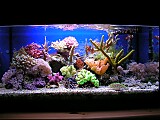
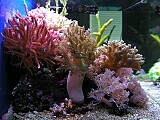
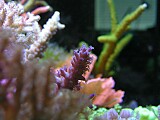
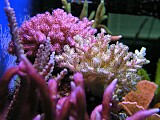
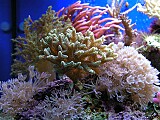
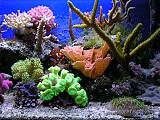
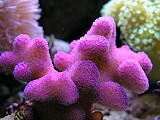
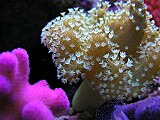

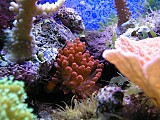
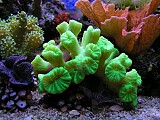
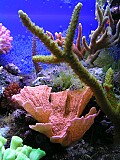
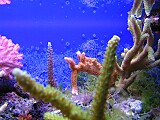
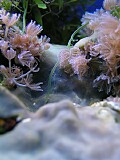

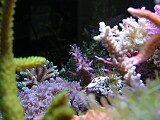
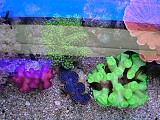
Photos 09/2005, Started 12/2004, Ended 2/2006
Tapio's nano reef is run with very easy, simple and efficient method. With this method it is possible to keep and grow even colourful sps corals in nano reef aquarium. The colours and the growth rate in our nano has been almost the same as they are in my main aquarium. Water remains chrystal clear, nitrates and phosphates are nearzero, and the maintenance is minimal. There has been a slow growth of various macroalgae species and no harmful microalgae growth at all. Several zooplankton species multiply in our nano and they are utilized by clown fishes. This is simply the best method to keep succesful nano reef aquarium.
Technical equipment:
1) Aquarium
A 54 l glass aquarium 60cm x 30cm x 30cm.
2) Filter
Eheim professionel 2226 is used. You can use almost any outside canister filter with at least two seperate filter chambers. The flow rate of the filter should be at least 10-20 times the volume of your aquarium.
3) Light
Four 15w normal output fluorescent tubes are used. Two of the tubes are blue and two are daylight tubes. They are overdriven by a single 2 x 54 w electric ballast. This gives you adequate light intensity to grow even colourful sps corals. We have changed the tubes in every 6 months, they don't last much longer because overdriven. If I founded the tank now, I would use ATI Powermodul 4 x 24w to get more light, it has just the right dimensions for our 54 l tank. I wouldn't use metal halide lights in nano reefs. With fluorescent tubes you get much even and softer illumination of the tank and less heat problems.
4) Reverse osmosis or deionisation unit
You need good quality water to make saltwater changes and to compensate evaporation with fresh water. Aqualight AL1 di unit is an excellent choice and a cheap one if you have only nano reef.
This can really be all the technical equipment you need. The protein skimmer is totally unnecessary. In our setup we don't also need any heater. The temperature of the water is within 25-30 degree celcius if the room temperature is 21-24 degree celcius. In different setups you may need a heater or to cool your tank with ie. a fan directed to water surface. In the tank we have 5cm of coral sand (0-2mm) in the bottom. It is better if you get some live sand from matured tanks. There is about 8 kg fresh live rock in the tank.
The heart of this system is in the canister filter. In the lowest chamber there is good quality coarse activated carbon like Eheim Ehvi Aktiv and coarse iron based phosphate remover like Korellen-zucht Biophos 2. They are in passive circulation placed in the sparse filter bag so that the water can run freely passing them. When you first start your tank, you might but them in active circulation. We used about 2 dl carbon and 1 dl Biophos in our filter. We have changed them every 3-6 months. In the second chamber there is Seachem denitrate in also passive circulation. We have used about 0.5l in our filter. Seachem denitrate has high porosity to support both aerobic and anaerobic bacteria and it removes nitrates, nitrites and organics from water. More denitrate you use, more quickly they will drop, so be careful of that. You should exchange denitrate when the nitrates start to rise.
We compensate evaporation by pouring about 1l fresh water every other day to the aquarium. In the fresh water we mix 1 tablespoon of CaCl2 or 1 tablespoon of NaHCO3 alternately to keep Calcium and KH in the nano in natural levels. Also five drops of Korallen-zucht Aminoacid Concentration and one drop of Lugol's solution is added at the same time.
20% water change is done every two weeks using Tropic Marin Pro Reef or Aqua Medic Reef Salt, the salinity is 35 ppt.
The fish are fed daily with a little flake or frozen food.